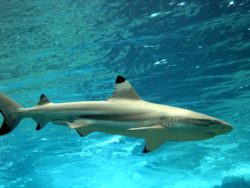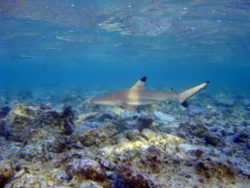
Sea Wonder: Blacktip Reef Shark
 Named for their distinct black tipped fins along their bodies and presence in shallow waters near reef, blacktip reef sharks are one of the smaller species of shark in the world’s ocean.
Named for their distinct black tipped fins along their bodies and presence in shallow waters near reef, blacktip reef sharks are one of the smaller species of shark in the world’s ocean.
Description
Blacktip reef sharks can reach lengths of up to seven feet when full grown, but on average grow to be closer to five feet long, and can weigh more than 50 pounds, but closer to 30 on average. Their bodies are brown/gray in color, they have oval-shaped eyes, their snouts are rounded and full of angled, saw-like teeth, and the edges of their fins are black with white streaks as their name suggests. As a form of countershading (camouflage) that helps them hunt successfully, these sharks have a white belly that contrasts with their darker backs.
Diet & Habitat
Blacktip reef sharks are carnivorous and have a diet mostly composed of reef fish, though they also consume stingrays, crabs, squid, octopus, shrimp and other invertebrates on occasion. They are fast, pursuit predators and have been observed hunting cooperatively with other sharks by herding schools of fish along the shore.
These sharks prefer shallow waters near coral reefs in the Indian and Western Pacific Oceans, including in National Marine Sanctuary of American Samoa and the adjacent Rose Atoll Marine National Monument. Their home ranges are often quite small and they remain loyal to a small area near reefs and drop-off zones, traveling in waters as shallow as one foot to as deep as 250 feet, generally traveling beyond their home area when food availability or water temperature changes. As a result, blacktip reef sharks are commonly encountered by people in tropical Indo-Pacific reefs, but they don’t pose a lethal danger to humans.
In some instances, blacktip reef sharks have been observed in brackish water lagoons or river mouths, which means they are likely adapted for a range of environmental conditions such as salinity and water temperature.
Life History
Blacktip reef sharks are viviparous breeders, which means fertilized eggs hatch within the womb and are supported by a yolk-sac placenta for about 10- to 16-months until they are born live. Litter sizes range from two to four pups (but are rarely as large as 10 pups!), and births usually occur when waters are a moderate temperature, meaning most occur in the late winter through the early summer months. Pups are largely independent at birth and grow until they reach maturity when they reach their full body size — at around four years old for males and seven years old for females. The average lifespan for blacktip reef sharks is about 13 years old, but sometimes they live longer in the right conditions.

Photo Credit: David Burdick
These sharks can be found swimming alone or in small groups, though not much is known about their social behaviors beyond foraging and breeding.
Threats & Conservation
Blacktip reef sharks are not listed as threatened or endangered anywhere in the world but populations are declining, mostly due to overfishing. Commercial fisheries often target this species for their meat, liver oil, and fins. Their small litter sizes and longer gestation periods make them especially vulnerable to population decline since it takes longer to replace individuals removed from the population. Other threats to the species include habitat loss, competition with fisheries, ocean acidification, and climate change.
